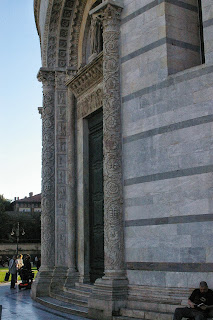Florence Day 7
This morning we packed and then in the early afternoon went out with the hope that a Museum which focused on the daily life of the Florentine in the 14th C would be open - in spite of the web site ay it would be closed when we got there.
On the way we saw an entry to Orsansmichele and went in....
 |
| The right hand Alter with an Icon in the centre. |
The church was originally a loggia for a market. Then it became a grain store and finally it was converted into a church which was patronised by a number of important (Wool, Lawyers and Judges and not some not? so important guilds, masons etc)
 |
| The beautiful windows behind the left hand alter. |
 |
| Another view of the Duomo as we walked back from the Orsansmichele |
Off to Pisa
The next morning we checked out of our apartment in Firenze and got a taxi to the Avis office. Into our diesel Audi A3, set the tomtom to take us to the centre of Pisa and we were off. managed to get out of Florence without a) having an accident in the narrow streets and b) without causing an accident, only got cursed once.
The outer suburbs of Florence are pretty dreary but we were soon in the countryside. It looked like Selma (our name for the voice on our tom-tom) was going to take us by a sort of AutoStrada to Pisa, so at a random, well we saw a hill castle near an exit labelled San Miniato, so we took the exit and drove up the hill and discovered San Miniato, a hill town with its origins lost in paleolithic history and documented with the Legions of Augustus who settled there before the current era.
 |
Some of the houses in San Miniato from the car park for the town
(Part way down the cliff face.) |
 |
| The town gate in ages past. Still blocks the main street below the castle. |
 |
| From the top of the wall looking west |
 |
| The church plaza with the remnants of the castle to the left. It was destroyed by the Germans as they retreated north, so the Americans could not use it as an artillery sighting tower. It has been re built. The main church is to the right of the round tower in the centre. |
 |
The inside of the Church of San Miniato. It was magnificent,
and out of keeping with the current town. |
In medieval times, San Miniato was on the via Francigena, which was the main connecting route between northern Europe and Rome. It also sits at the intersection of the Florence-Pisa and the Lucca-Siena roads. Over the centuries San Miniato was therefore exposed to a constant flow of friendly and hostile armies, traders in all manner of goods and services, and other travelers from near and far.
Archaeological evidence indicates that the site of the city and surrounding area has been settled since at least the
paleolithic era. It would have been well known to the
Etruscans, and certainly to the
Romans, for whom it was a military post called "Quarto".
The first mention in historical documents is of a small village organized around a chapel dedicated to San Miniato built by the
Lombards in 783. By the end of the 10th century San Miniato boasted a sizeable population enclosed behind a moat and protected by a castle built by
Otto I, from which an Imperial Vicar ruled all of Tuscany.
The first walls, with defensive towers, were thrown up in the 12th century during the time that Italy was dominated by
Frederick Barbarossa. Under his grandson,
Frederick II, the town was further fortified with expanded walls and other defensive works, including the Rocca and its tower.
During the latter years of the 13th century and the entire 14th century, San Miniato was drawn into the ongoing conflict between the
Ghibelline and
Guelph forces. Initially Ghibelline, it had become a Guelph city by 1291, allied with Florence and, in 1307, fought with other members of the Guelph league against the Ghibelline
Arezzo.
By 1347 San Miniato was under Florentine control, where it remained, but for a brief period from 1367-1370 when, instigated by Pisa, it rebelled against Florence, and for another brief period between 1777 and 1779 during the Napoleonic conquest. It was still part of the
Grand Duchy of Tuscany when the Duchy was absorbed into the newly formed
Kingdom of Italy in 1860. (extract from the Wikipedia article on San Miniato)
 |
| The view from San Miniato |
 |
The tower is one of the earliest examples of a crenelated castle tower.
It is now part of a hotel and Restaurant that sit on top of the old wall.
We had a very good lunch in the restaurant overlooking the plains below. |
 |
This was a convent and hospital. There is still a hospital here at the end nearest us.
|
 |
| The hotel and Restaurant. The restaurant windows are at the left ubder the sloping roof. |
On to Pisa
After lunch we set off down the hill and wound our way to Pisa by country roads getting a good view of the old towns and farms.
Tomorrow we will look at the inside of the Baptistry and the Duomo.



























No comments:
Post a Comment